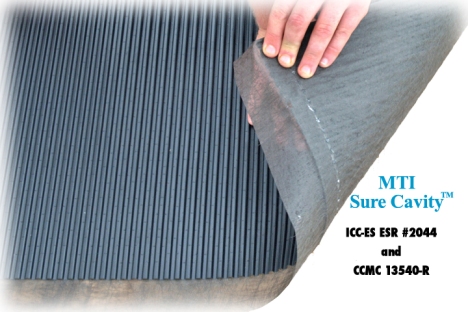I know that imitation is supposed to be the sincerest form of flattery; however, when imitation is based on false claims, I’m not flattered! MTI’s Sure CavityTM rainscreen drainage plane is the first and only rainscreen drainage plane on the market today that has “true” channels. Sure CavityTM has always been configured with this channel technology since its innovative birth more than two decades ago. Our competitors know that it is the “best” technology to quickly drain water from a high point to a low point and out of the rainscreen building envelope. That’s why some are now claiming that they have “channel” technology, even though they don’t.
Webster’s New World Dictionary defines a channel as “a tubelike passage for liquids.” Most school kids, if asked to draw a channel, would probably draw a couple of straight lines with some blue water in between. When I did a Google image search for channel, the pictures that came up generally showed relatively straight banks (or sides) with water between those straight sides (ie. the Panama Canal, Erie Canal, etc.) I am totally amazed how someone can look at a piece of fibrous plastic (think of a kitchen scrub pad) and see channels! The whole idea behind an effective rainscreen drainage plane is moving moisture “quickly” down from a high point to a low point. Water does not move quickly when it has to twist its way through a maze of fibrous material! You can even add some vertical waves to the pattern but you aren’t really creating channels, and the fibrous makeup of the drainage material still puts a myriad of roadblocks in the path of the water you are trying to “quickly” get out of the wall.
A wise marketer once said, “It’s your ad, you can say what you want.” I suppose that is true, but is it right? MTI doesn’t have to make up product features in order to market our Sure Cavity rainscreen drainage plane products as the best moisture management solution. We are the leader; our rainscreen drainage plane products have the technology others envy (and attempt to imitate), and our ICC and CCMC Evaluation Reports confirm that Sure Cavity works the way it is supposed to work. No other manufacturer of drainage plane products on the market today have both a CCMC and ICC Evaluation Report for their drainage plane products. None! So I guess the old “Caveat Emptor – Let the buyer beware!” adage still hold true; kind of sad, isn’t it.
Filed under: 1, Daily Dose of Masonry, Moisture Management, News and Updates | Tagged: building envelope moisture management, drainage mat, mti, rainscreen drainage plane, sure cavity, sustainability | Leave a comment »








